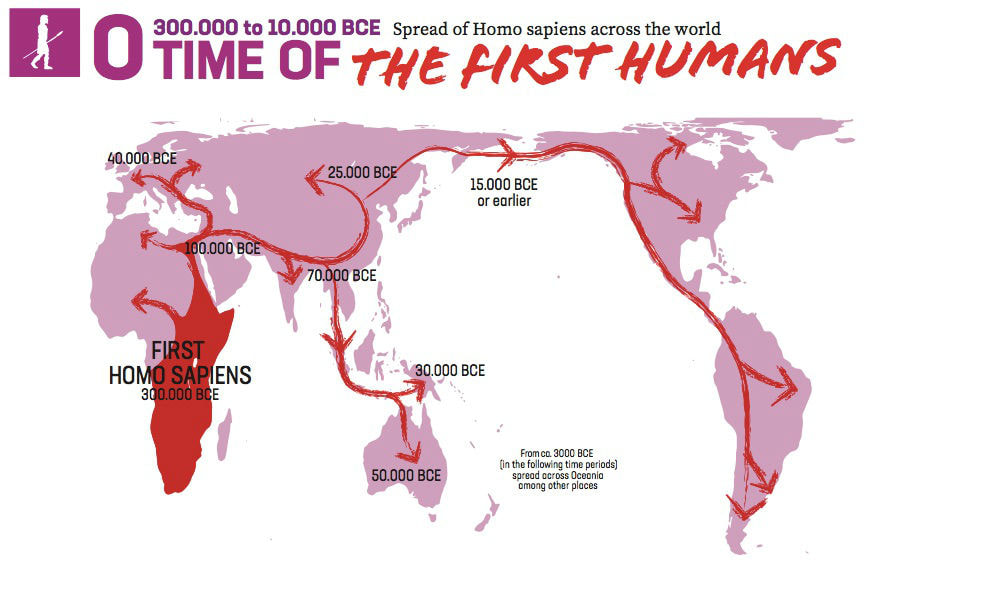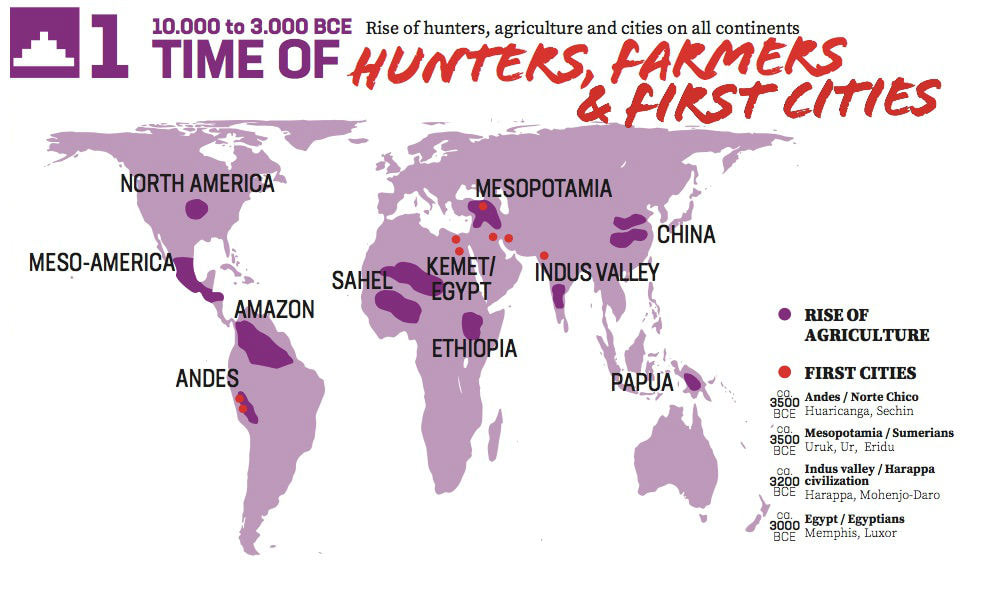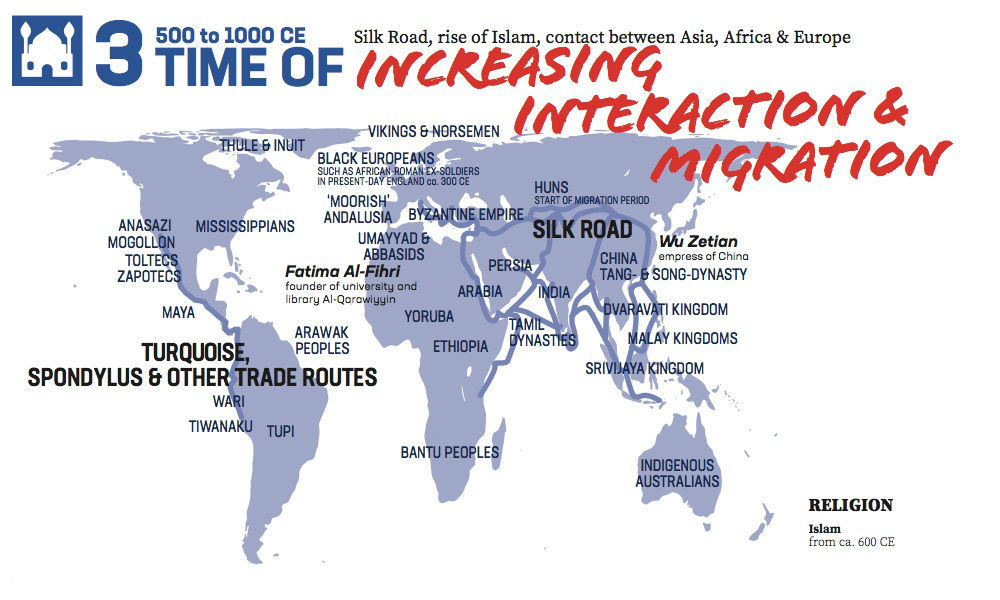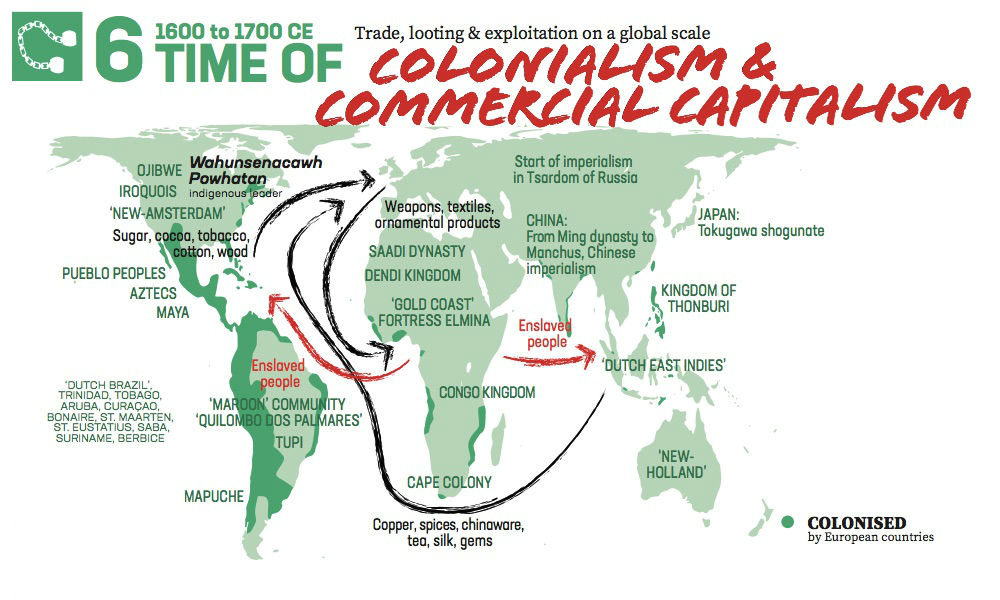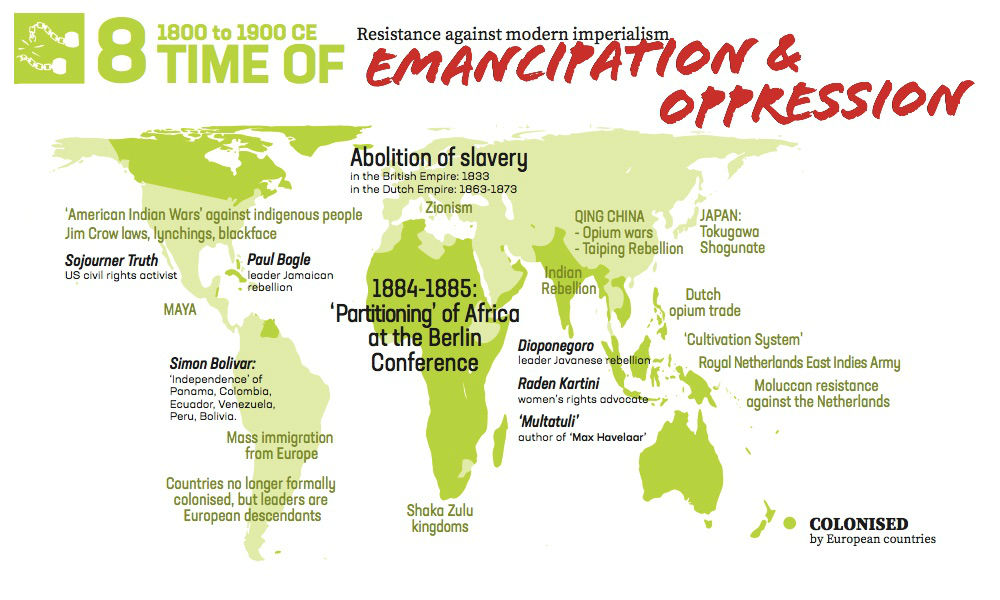Find out more about the poster '10 x more history'
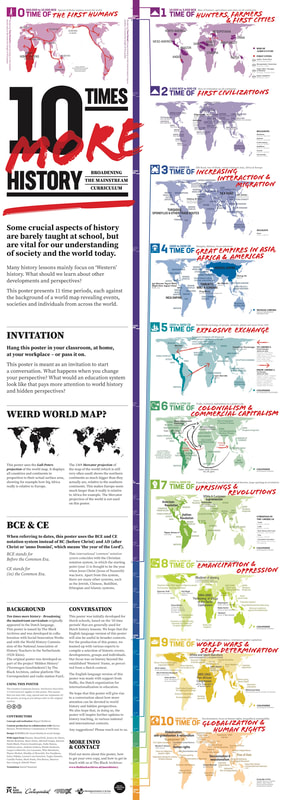
On this page you will find more information about the poster 'Ten times more history – Broadening the mainstream curriculum'.
Please note: We are gradually adding more information to this page, so be sure to check back soon for additional content.
The poster 'Ten times more history – Broadening the mainstream curriculum' originally appeared in the Dutch language. The Black Archives developed the poster in collaboration with Social Innovation Works (continued with 'Fawaka WereldBurgerschap' / Fawaka Global Citizenship education) and the World History Commission of the National Association of History Teachers in the Netherlands (VGN Kleio). The original poster was developed as part of the project ‘Hidden History’ (Dutch: 'Verzwegen Geschiedenis') of The Black Archives, online platform The Correspondent and radio station FunX.
The poster aims to promote education about world history and hidden perspectives – and to stimulate discussion about these topics.
This poster was initially developed for Dutch schools, based on the ‘10 time periods’ that are generally used for Dutch history lessons. We hope that the English-language version of this poster will also be useful in broader contexts.
For the production of the poster, we teamed up with various experts to compile a selection of historic events, developments, groups and individuals. Our focus was on history beyond the established ‘Western’ frame, as perceived from a Dutch context. We hope that this poster will give rise to a conversation about how more attention can be devoted to world history and hidden perspectives. We also hope that, in doing so, the poster will inspire further updates to history teaching, in various national and international contexts.
Any suggestions? Please get in touch with us via [email protected].
GET YOUR OWN COPY
The posters can be purchased for €8 each or €60 for 10 copies, at The Black Archives in Amsterdam (address: Zeeburgerdijk 21), during the regular opening hours of our exhibitions.
If you have a question about obtaining a copy of the poster, please contact us at [email protected] or for the Netherlands: buy it directly from our webshop.
DISTRIBUTION
We are happy to distribute the posters in partnership with educational organizations and other parties. Please contact us about this at [email protected].
USING THE POSTER
The Creative Commons licence ‘Attribution-ShareAlike 4.0 International’ applies to this poster. This means that you may edit, copy, spread and use (segments of) this poster, as long as you always refer to the original version.
The posters can be purchased for €8 each or €60 for 10 copies, at The Black Archives in Amsterdam (address: Zeeburgerdijk 21), during the regular opening hours of our exhibitions.
If you have a question about obtaining a copy of the poster, please contact us at [email protected] or for the Netherlands: buy it directly from our webshop.
DISTRIBUTION
We are happy to distribute the posters in partnership with educational organizations and other parties. Please contact us about this at [email protected].
USING THE POSTER
The Creative Commons licence ‘Attribution-ShareAlike 4.0 International’ applies to this poster. This means that you may edit, copy, spread and use (segments of) this poster, as long as you always refer to the original version.
CONTENT OF THE POSTER:
Below you will find more information about the content of the poster 'Ten times more history – Broadening the mainstream curriculum'.
Please note: We are gradually adding more information to this page, so be sure to check back soon for additional content.
Some crucial aspects of history are barely taught at school, but are vital for our understanding of society and the world today. Many history lessons mainly focus on ‘Western’ history. What should we learn about other developments and perspectives?
The poster presents 11 time periods, each against the background of a world map revealing events, societies and individuals from across the world.
INVITATION
We invite you to hang the poster in your classroom, at home, at your workplace – or pass it on. The poster is meant as invitation to start a conversation. What happens when you change your perspective? What would an education system look like that pays more attention to world history and hidden perspectives?
Please note: We are gradually adding more information to this page, so be sure to check back soon for additional content.
Some crucial aspects of history are barely taught at school, but are vital for our understanding of society and the world today. Many history lessons mainly focus on ‘Western’ history. What should we learn about other developments and perspectives?
The poster presents 11 time periods, each against the background of a world map revealing events, societies and individuals from across the world.
INVITATION
We invite you to hang the poster in your classroom, at home, at your workplace – or pass it on. The poster is meant as invitation to start a conversation. What happens when you change your perspective? What would an education system look like that pays more attention to world history and hidden perspectives?
Period 0: Time of the first humans
This period shows the spread of humans (Homo sapiens) around the world from Africa and South Asia, from around 300,000 years ago (!) to around 12,000 years ago.
Links are continually being added. Suggestions? Please contact us at [email protected].
Links are continually being added. Suggestions? Please contact us at [email protected].
Period 1: Time of hunters, farmers and first cities
The world map of this period shows that agriculture originated before 3000 BCE in different places in the world (in North America, Central America, in the Amazon and the Andes, in Mesopotamia, in Egypt, in the Sahel, in Ethiopia, in present-day China, in the Indus Valley and in Papua / present-day Indonesia). Around that same time (about 5000 years ago), the first cities came into existence in the Andes, in Mesopotamia, in the Indus Valley and in Egypt.
Origin of agriculture:
First cities:
Origin of agriculture:
- Read more about the history of agriculture and the Neolithic Revolution (Wikipedia).
First cities:
- Norte Chico: Read more on Wikipedia.
- Uruk, Ur, Eridu: Read more on Wikipedia.
- Harappa civilization: Read more on Wikipedia.
- Egypt: Read more on Wikipedia.
Period 2: Time of first civilizations
The world map of this period shows that many civilizations emerged simultaneously in this period. Not only in Europe, but also in Africa, Asia and the Americas.
Other links are being added. Suggestions? Please contact us at [email protected].
- Imhotep: Read more about Imhotep.
- Gilgamesh: Read more about Gilgamesh and the epic of Gilgamesh.
- Norte Chico: Read more about this on Wikipedia.
- Teotihuacán: Read more about this on Wikipedia.
Other links are being added. Suggestions? Please contact us at [email protected].
Period 3: Time of increasing interaction and migration
The world map of this period among other things shows the land and marine trade routes that connected Asia, Africa and Europe at this time. These continents did not yet interact with the Americas in this period. Other trade routes that connected parts of the Americas internally did exist.
Other links are being added. Suggestions? Please contact us at [email protected]
- Fatima El-Fihriya: Read more on Wikipedia.
- Wu Zetian: Read more on Wikipedia.
Other links are being added. Suggestions? Please contact us at [email protected]
Period 4: Time of great empires in Asia, Africa and Americas
The world map of this period shows that economic progress that occurred in Europe coincided with and was related to developments in the Islamic world and other empires. In Asia this included (but was not limited to) the Mongolian empire, one of the largest empires ever. In Africa this included Mali. In South America the Inca and Aztec empires flourished.
Other links are being added. Suggestions? Please contact us at [email protected]
- King Musa: Read more on Wikipedia.
- Eight Deer Jaguar Claw: Read more on Wikipedia.
- Ibn Battuta: Read more on Wikipedia.
- Zheng He: Read more on Wikipedia.
Other links are being added. Suggestions? Please contact us at [email protected]
Period 5: Time of explosive exchange
In 1492 Columbus sailed from Spain to the Americas (initially around what are now the Bahamas and Cuba). This was the starting point of a period of explosive exchange in all sorts of areas between the Americas on the one hand, and Europe, Africa and Asia on the other. The world map of this period also contains examples of world travelers from parts of the world other than Europe: Juan Garrido, Hasekura Tsunenaga and Manteo.
Other links are being added. Suggestions? Please contact us at [email protected]
- Hasekura Tsunenaga: Read more on Wikipedia.
- Manteo: Read more on Wikipedia.
- Juan Garrido: Read more on Wikipedia.
- Permanent residents with an African and Asian background in the Netherlands: See the article An Afro-Dutch community in the seventeenth century.
- Exchange: Read more on Wikipedia.
Other links are being added. Suggestions? Please contact us at [email protected]
Period 6: Time of colonialism and commercial capitalism
When it comes to the Netherlands, the seventeenth century is often called the 'Golden Age'. From the viewpoint of many other regions, the same period is a time of colonization in which (Western) European countries are forcibly acquiring a dominant position in old and new trade routes. The world map of this period shows, among other things, the so-called 'transatlantic' trade, or 'triangular trade', in which goods and also enslaved people were shipped. The map also shows the Maroon village 'Quilombo dos Palmares', where enslaved Africans in South America revolted against slavery regimes.
Links are being added. Suggestions? Please contact us at [email protected]
- Quilombo dos Palmares: Read more on Wikipedia.
Links are being added. Suggestions? Please contact us at [email protected]
Period 7: Time of uprisings and revolutions
The world map of this period shows several major revolutions that took place during this period: the French Revolution, American Revolution, and also the Haitian Revolution. In Haiti, which was then the French colony Saint-Domingue, enslaved Africans organized an uprising that led to the establishment of an independent state. Listed on the world map is an overview of various uprisings in the Americas.
Other links are being added. Suggestions? Please contact us at [email protected]
- Haitian Revolution: Read more on Wikipedia.
- Cuffy: Read more on Wikipedia.
Other links are being added. Suggestions? Please contact us at [email protected]
Period 8: Time of emancipation and oppression
The world map of this period shows, among other things, that in this period many South American countries became 'independent', slavery was formally abolished in a number of countries, large parts of Africa were 'partitioned' by European countries at the Berlin Conference, and several revolts were carried out in Asia. While democratization and emancipation were slowly taking shape in Europe, the domination of European countries - and in particular the British Empire - was putting an ever-increasing stamp on the world.
Other links are being added. Suggestions? Please contact us at [email protected]
- Sojourner Truth: Read more on Wikipedia.
Other links are being added. Suggestions? Please contact us at [email protected]
Period 9: Time of world wars and self-determination
The world map of this period shows, among other things, a call for independence and 'human rights' at the Pan-African Congresses held in the whole first half of the twentieth century. The map also shows activism in the Americas and Asia.
Links are being added. Suggestions? Please contact us at [email protected]
Links are being added. Suggestions? Please contact us at [email protected]
Period 10: Time of globalization & human rights
International human rights were launched by the United Nations (founded in 1945) after the Second World War. The world map of this period also pays attention to the development of decolonization and globalization. And there is also attention for inequality and sustainability.
Links are being added. Suggestions? Please contact us at [email protected]
Links are being added. Suggestions? Please contact us at [email protected]
More on 'Hidden History'
As part of the 'Hidden History' project, a series of articles has been published about various topics that are highlighted on the poster (on the website of De Correspondent, in Dutch). At De Correspondent you can read about over twenty hidden histories that deserve a place in our school textbooks (articles in Dutch).
COLOPHON
‘Ten times more history - Broadening the mainstream curriculum’ originally appeared in the Dutch language. The poster is issued by The Black Archives and was developed in collaboration with Social Innovation Works (continued with 'Fawaka WereldBurgerschap' / Fawaka Global Citizenship education) and the World History Commission of the National Association of History Teachers in the Netherlands (VGN Kleio). The original poster was developed as part of the project ‘Hidden History’ ('Verzwegen Geschiedenis') of The Black Archives, online platform The Correspondent and radio station FunX.
Concept and realisation: Miguel Heilbron
Content production in collaboration with: Marian Heesen, World History Commission of VGN Kleio
Design: BUROBRAAK visual identity and social design
With input from: Hanane Abouellotfi, Jessica de Abreu, Martin Bootsma, Mano Delea, Mitchell Esajas, Karwan Fatah-Black, Francio Guadeloupe, Fadie Hanna, Antheun Janse, Andreas Jonkers, Rinske Koehorst, Caspar Lobbrecht, Leo Lucassen, Wim Manahutu, Wayne Modest, Khadija al Mourabit, Eva Naaijkens, Grâce Ndjako, Lennert van Oorschot, Tugba Oztemir, Camille Parker, Mark Ponte, Pim Renou, Maurice San-A-Jong & Alderik Visser
Translation: Daniel Naamani
VIDEO
Watch the video of the launch of the original Dutch poster below (in Dutch). On Saturday 1 June 2019 we launched the original Dutch poster at The Black Archives. We spoke with various speakers about the need for a broader view in history education.
COLOPHON
‘Ten times more history - Broadening the mainstream curriculum’ originally appeared in the Dutch language. The poster is issued by The Black Archives and was developed in collaboration with Social Innovation Works (continued with 'Fawaka WereldBurgerschap' / Fawaka Global Citizenship education) and the World History Commission of the National Association of History Teachers in the Netherlands (VGN Kleio). The original poster was developed as part of the project ‘Hidden History’ ('Verzwegen Geschiedenis') of The Black Archives, online platform The Correspondent and radio station FunX.
Concept and realisation: Miguel Heilbron
Content production in collaboration with: Marian Heesen, World History Commission of VGN Kleio
Design: BUROBRAAK visual identity and social design
With input from: Hanane Abouellotfi, Jessica de Abreu, Martin Bootsma, Mano Delea, Mitchell Esajas, Karwan Fatah-Black, Francio Guadeloupe, Fadie Hanna, Antheun Janse, Andreas Jonkers, Rinske Koehorst, Caspar Lobbrecht, Leo Lucassen, Wim Manahutu, Wayne Modest, Khadija al Mourabit, Eva Naaijkens, Grâce Ndjako, Lennert van Oorschot, Tugba Oztemir, Camille Parker, Mark Ponte, Pim Renou, Maurice San-A-Jong & Alderik Visser
Translation: Daniel Naamani
VIDEO
Watch the video of the launch of the original Dutch poster below (in Dutch). On Saturday 1 June 2019 we launched the original Dutch poster at The Black Archives. We spoke with various speakers about the need for a broader view in history education.
Watch the video of the launch of the original Dutch poster below (in Dutch)
Openingstijden/Opening TimesWoensdag/Wednesday 11.00 - 17.00 uur
Donderdag/Thursday 11.00 - 17.00 uur Vrijdag/Friday 11.00 - 17.00 uur Zaterdag/Saturday 11.00 - 17.00 uur Onze nieuwe locatie in Amsterdam Zuidoost is geopend. Neem contact op via de pagina contact voor rondleidingen buiten het programma. We moved to South East Amsterdam. Contact us via the page contact for tours outside our program. |
(Rolstoel)toegankelijkheid/Accessibility
Momenteel beschikt The Black Archives niet over een speciale ingang en lift voor personen met een fysieke beperking en voor rolstoelgebruikers.
At this moment, The Black Archives does not have a special entrance or lift for person of disability. |

